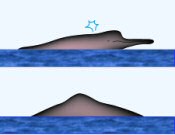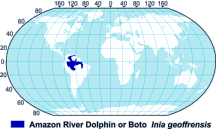Boto (Amazon River Dolphin)
CLASS: Mammalia
ORDER: Cetacea
SUBORDER: Odontoceti
FAMILY: Iniidae
GENUS: Inia
SPECIES: Geoffrensis
The Amazon River Dolphin, also called the boutu, boto, or bufeo, is the largest of the freshwater dolphins, and like all freshwater dolphins it is endangered because of hunting, human pressures, and degradation of habitat. Its most amazing characteristic is its color, which ranges -- depending on its age -- from soft, rosy pink to a vivid, almost shocking pink. The Portuguese name for this species in Brazil is "boutu vermelho" — red dolphin.
Physical Description
The Amazon River dolphin, or boutu, is a fresh water dolphin of medium size, with a heavy, thickset body. It has a prominent domed forehead ending in a long beak which contains 24 to 34 conical and molar-type teeth on each side of the jaws. The conical teeth are in the forward part of its mouth and are used for holding and grasping prey which is then worked to the rear of the mouth to be thoroughly crushed by the molars before being swallowed. Another unique feature of this dolphin is the presence of stiff hairs on the upper and lower portions of the beak. It is thought these hairs provide a "sense of touch" while the animal forages in the mud for food. Its mouth is wide and straight and curves upward at the corners. The neck vertebrae are not fused together and this dolphin is able to bend its neck to an angle of 90 degrees to its body, downward or sideways. Though its eyes are small its eyesight is good. The ear opening is large and the Amazon River dolphin is known to have a well developed sense of hearing.

Surface Characteristics
Color
Its color is distinctive and varies considerably according to age. When it is young, the Amazon River dolphin is dark gray on the upper portion of its body. As it matures the gray is replaced by pink on the ventral or lower portion of the body, which spreads up the sides to the back. The color becomes lighter as the dolphin matures, and ends up almost white, with tinges of bluish-gray.
Fins and Fluke
Instead of a dorsal fin, the boutu has a ridge on its back which rises to a modified hump at about the mid section of its body. Its flippers are large in proportion to its body and are used for steering. Its flukes are large and broad and divided by a median notch. Its unusually large flippers and flukes are probably an adaptation for maneuvering in shallow waters.
Length and Weight
Length averages about 6 feet for males (2.5 m) with a maximum of 9 feet (2.7 m); females average 6 feet (1.8 m) with a maximum of 8 feet (2.4 m). Weight is up to 350 pounds (160 kg).
Feeding
Amazon River dolphins feed on Amazon catfish and other heavily scaled fish, including piranhas, as well as bottom-dwelling crustaceans.
Mating and Breeding
The male reaches sexual maturity at about 7 feet (2 m) and the female at about 5.5 feet (1.7 m). Most calves are born between July and September after a gestation period of 9 to 12 months; they are about 32 inches long at birth (80 cm) and weigh about 15 pounds.

Range Map
The boutu is found everywhere in northern and central South America from the Amazon River delta to the Andes. It is plentiful in the Amazon and its tributaries and lakes as well as the Orinoco River and its tributaries in Venezuela. It also inhabits rivers in Columbia, Ecuador, northern Peru, Brazil, and Bolivia. Depending on where it is found, differences in color, number of teeth, size, and other physical characteristics have been reported in well-separated populations. Because of these differences some scientists think boutus should be separated into different species and subspecies.
Distribution and Migration
The boutu is usually seen alone or in pairs. It is curious and is not shy about approaching boats. The sounds it makes are clearly audible and are used for echolocating prey. While echolocating, the boutu uses a scanning technique, moving its head from side to side — a maneuver made possible by the flexibility of its neck.
Natural History
In some parts of its range the boutu has figured prominently in the folklore of the South American Indians, who believed killing them would bring bad luck and misfortune. These taboos provided the animal with a measure of protection until new settlers began to arrive and live along the river banks. Since then large numbers of dolphins have been killed and their skins used for leather; their fat for cooking. In addition, several hundred have been captured live for display in aquariums. The U.S. alone took nearly 100 of them; less than 20 were able to adapt to captivity.
Bibliography
- Jefferson, T.A., M.A. Webber, R.L. Pitman. 2015. Marine Mammals of the World: A Comprehensive Guide to their Identification, 2nd edition. Elsevier/AP.
- Montgommery, S. 2000. Journey of the Pink Dolphins: An Amazon Quest. Simon & Schuster.
Acknowledgements
Illustrations courtesy Uko Gorter, copyright ©2017 all rights reserved.
FACT SHEETS MAY BE REPRINTED FOR EDUCATIONAL OR SCIENTIFIC PURPOSES
|



